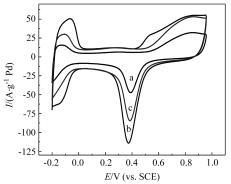化学学报 ›› 2011, Vol. 69 ›› Issue (10): 1179-1185. 上一篇 下一篇
研究论文
赵佳越, 周益明, 吴云胜, 唐亚文, 陈煜, 陆天虹
ZHAO Jia-Yue, ZHOU Yi-Ming, WU Yun-Sheng, TANG Ya-Wen, CHEN Yu, LU Tian-Hong

比较了未氧化处理与经浓硝酸或混酸(浓硫酸与浓硝酸体积比为1∶1)处理后的不同多壁碳纳米管(MWNTs)为载体的Pd催化剂(Pd/MWNTs)对水合肼氧化的电催化性能. 光谱表征和电化学测试结果表明, MWNTs表面不修饰或修饰程度过大都不利于金属Pd纳米粒子的沉积. 浓硝酸处理使MWNTs表面修饰的含氧基团适中, 能够促进负载的Pd纳米粒子均一分布, 因此提高Pd/MWNTs催化剂对水合肼的电催化性能. 相反, 混酸处理使MWNTs表面产生的含氧基团过多, 导致金属Pd纳米粒子部分聚集, 从而降低Pd/MWNTs催化剂对水合肼的电催化性能.